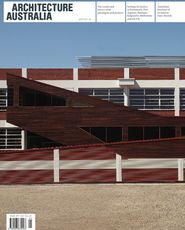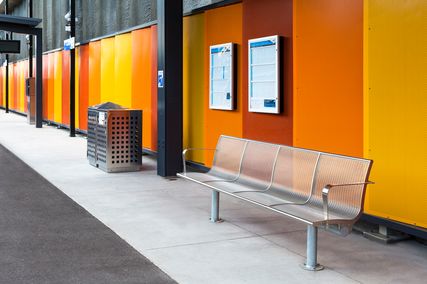
The terrorism court (2005), in the wing of the Palais de Justice, Paris. Note the glazed dock for multiple defendants. The defence lawyers sit directly in front of the dock and the sliding glass panels facilitate interaction between the defendants and their advocates. Photograph taken by Diane Jones during the Court of the Future executive research seminar, Paris, September 2005.
Juries are a central part of a modern justice system, both in countries like Australia or the US that have a common law heritage, and those like France or Russia that have a civil law history. Juries – motley groups of ordinary citizens – make serious decisions, which can have enormous consequences for the liberty and property of others. With such a burden of responsibility, they clearly have a special role in the justice system. Unlike all the other lay participants in the justice system who flood into courts, however, jurors have a position of real authority. It is this strange paradox of being both “ordinary” and “special” that makes juries a particular challenge for those charged with designing courts.
Indeed, there is something slightly scandalous about the jury altogether. Most other major decisions made in courts are safely entrusted to professionals, experienced people trained in their craft who must account for their actions. Juries meanwhile need no prior training; indeed one of their only qualifications for service is that they know nothing at all about the case they are judging. Nor do they need to justify their decision to anyone. For a judicial system that privileges professionalism, neutrality and accountability, the introduction into key decision-making roles of amateurs full of unknown prejudices who do not need to justify their decisions is bound to produce interesting results. The challenge for court designers is how to represent the scandal of this democratic intrusion into a space otherwise reserved for professionals.
One way to think about this is as a balance that needs to be struck between segregation and equality. It can be argued that recent courthouses, with up to six separate circulation systems, are some of the most segregated buildings in the modern world. Judges, court staff, prisoners, protected witnesses, the public – and jurors – may have their own distinct network of entrances, staircases, elevators, bathrooms and waiting areas. Courtrooms themselves reflect this fragmentation with separate doors for members of each caste. As “ordinary” citizens, jurors typically enter the building through the public entrance and pass through security. Once they are selected for possible inclusion on a jury, they acquire a “special” status, and move along a dedicated jury corridor to the courtroom. If they are not empanelled, they return along the dedicated transition path to the jury assembly area, before being discharged out the public exit. If empanelled, their “special” status might allow them to enter and exit the building using a dedicated entrance. These movements describe an ideal case, achieved in only a few courts, such as the Victorian County Court. Courts which cannot achieve high levels of segregation through design use instead staff, signs or careful choice of route to avoid jurors overhearing conversations, accidentally meeting witnesses or being intimidated by those outside the jury.
Because they are drawn from the public, jury members, once consecrated to their special duties, must avoid contact with other members of the public who are not so designated. To avoid such contamination, jury rooms built before the 1980s were typically shielded from the public gaze, with particular efforts made to ensure jurors are not sent messages from outside. This can lead to restricting views from jury rooms, often by having no windows at all; in one large Sydney District Court building the first question some jurors ask the jury officers when they enter the jury room is “Who are the prisoners here?” On the other hand, jurors as important decision-makers may be said to need supportive deliberative environments. This can include views of nature, natural light and opportunities to seek visual relief. In other words, jury rooms and jury spaces in the courtroom, rather than being closed in, should be opened up. So the debate about having windows in jury rooms turns out to be, at least in part, a debate about whether jurors are seen primarily as ordinary members of the public who should be protected from the risk of contamination, or important decision-makers who should be offered comfortable surroundings congruent with their status.
A second form segregation in the common law courtroom takes is separation of the judge and the jury. In France, the nine lay jurors sit at the front of the courtroom, on either side of the three professional judges. This configuration, developed after the Vichy wartime regime, unified the culpability and sentence decisions by bringing the judges into the jury deliberation process. The visual message conveyed is that the citizen-judges have the same standing as their professional colleagues, even if the original intent of the changed arrangements was to warn jurors not to challenge state authority. In Australia, as with other common law countries, the jury has a different task from the judge – the jury decides about the facts and the judge on matters of law; the jury decides on guilt, the judge passes sentence. So the jury sits on the side, in a tiered configuration, with the back row of jurors often at the same height as the judge. The segregation from the judge within the courtroom provides a symbolic marker of separation of functions, and their separate entrances assure the public of the impossibility of a conspiracy between the two separate decision-making authorities in the courtroom.
If segregation is the key to marking the jury out from both the public and the judge, equality might be argued to be the principle they should use with each other. One reason why jury decisions must often be either unanimous or nearly so is to ensure all points of view must be taken into account. A simple majority system (such as that used in Scotland) could allow the majority view to be recorded as the decision of the whole jury without attention to other perspectives. So equal access to voice at the jury table is relevant to the quality of deliberation. The shape of jury table may influence the degree to which jurors seated in different positions can contribute and get a good line of sight to their peers. A rectangular table might privilege the person at the head of the table, or the people seated in the middle of the long side. Oval and round tables might promote greater equality. Appropriate lighting, clear acoustics and access to alternative forms of communication (like whiteboards) might also be relevant. Respect for cultural diversity can be reflected in the range of food available to jurors at lunch, even if the economy-class biscuits and tea bags served during the breaks remind them of their “ordinary” status.
The key battleground where the tension between equality and segregation is played out in the contemporary courthouse is not, however, in the jury room, or in the juxtaposition of judge and jury. It is in the spatial relationship between the accused and the jury, and the way this might be undermined by the development of glass cages around the accused. “Security docks”, as they are called, have increasingly been introduced in most states of Australia as well as France, the UK and elsewhere, to segregate the accused from the rest of the court, including the jury. Rather than the jury being visually presented as “peers” of the accused, the defendant is presented as a strange and perhaps dangerous “other” to be gazed at through the mediation of glass. One of the defining moments in this battle in Australia was the order by Justice Bernard Bongiorno in the Victorian Supreme Court, at the beginning of a major trial of a group of men charged with terrorism-related offences, to remove glass around the dock.
This debate about courtroom design points to a key feature of the jury system – jurors are “special” precisely because they are “ordinary”. They can understand what an ordinary person might do under certain circumstances because, in a hierarchical court system, they were drawn from, at least in principle, the same caste as the accused. Segregation of the accused from the jury would undermine the principle of common humanity that provides the basis for a jury of “peers”. It would also make it hard to get a sense of the accused from their demeanour, something which the US Supreme Court found to be part of the right of “confrontation”. Arguably the best way of avoiding segregation between the jury and the accused is to place the defendant at the bar table, following the practice in some other common law jurisdictions like the US, Ireland and New Zealand (mostly). In Australia, the ACT places the defendant just behind the bar table, without a dock. Alternatively the dock could be built out of the same combination of materials as the jury box, witness box and bench, symbolizing equality of all under the law. This was indeed almost the standard practice for contemporary courtroom design before the new demands for security docks started to take hold. So the design challenge for new courthouses is how to avoid pressures for new forms of segregation, and for present courtrooms to maintain configurations that provide symbolic equality between jurors and the accused.
David Tait is professor at Justice Research, University of Western Sydney.















